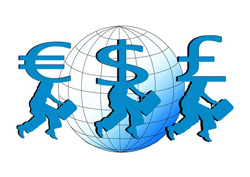 Are you planning to sell goods or services online globally? If so, then it’s a great idea to consider providing your web visitors with the convenience of currency conversion on your e-commerce web site.
Are you planning to sell goods or services online globally? If so, then it’s a great idea to consider providing your web visitors with the convenience of currency conversion on your e-commerce web site.
Currency conversion lets your prospects have the cost of a foreign currency amount translated into their local currency at the point of sale. It also lets visitors and customers see the exact amount their card or PayPal account will be charged, displayed in their own local currency.
The obvious advantage of displaying currency conversion is that it lets customers see and understand prices in foreign countries in their own local currency, and makes it easier for visitors to work out their costs and expenses.
If your site is built with WordPress, it’s simple to add currency conversion via a plugin to WordPress, allowing your visitors to quickly determine the cost of your goods.
Currencyr
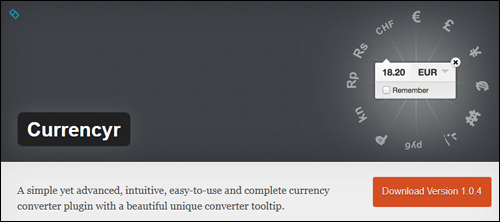
Currencyr is a simple, easy-to-use and complete currency converter plugin with a unique and attractive converter tooltip. Best of all, it’s free!
This useful plugin features:
- Inline converter
- Supports various exchange rates providers, such as Yahoo!, Open Exchange Rates and European Central Bank
- WP-Cron task scheduler enabled
- Currency table and converter widget
- Supports integration with a number of e-store plugins such as WooCommerce, WP-eCommerce, Shopp, and Easy Digital Downloads.
- Automatically detects local currency
- Support for language translations
Important: This plugin requires your server to be running PHP 5.3.0 or later. Do not install this plugin if you currently have an older version of PHP installed on your server. Alternatively, ask your web host to check and upgrade your PHP.
***
You can install the Currencyr plugin from your WP admin area by searching for “currencyr” in the Plugins section and clicking “Install Now” …
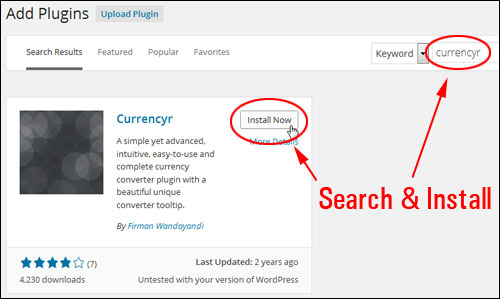
After installing and activating the plugin, you can configure the plugin’s settings by selecting Currencyr from your admin area …
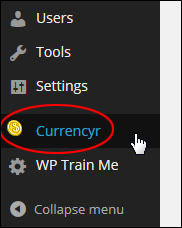
This takes you to the plugin settings area …
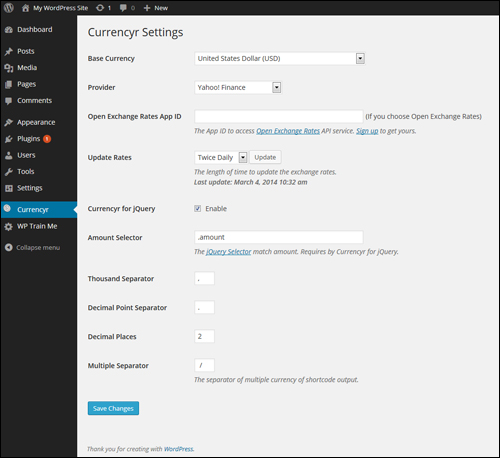
For example, you can select a base currency from a drop-down menu. The default base currency is ‘USD’ …
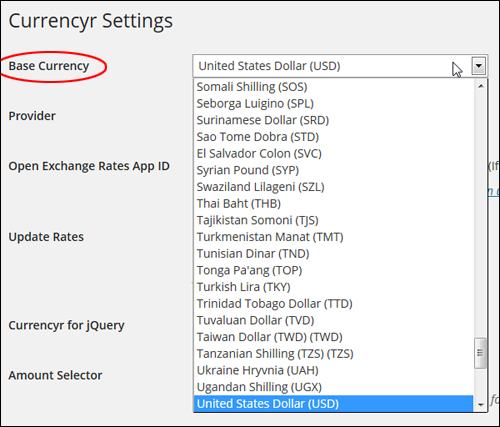
You can choose a data provider from a drop-down menu. The default provider is Yahoo Finance, but you can also choose one of the other options, such as European Central Bank, FoxRate, Google Finance or Open Exchange Rates …

Note: If you choose ‘Open Exchange Rates’ as your provider, you will need an API (Application Programming Interface) ID …

You can specify how often you would like to update the currency exchange rates by choosing an option from the Update Rates drop-down menu …

The Currencyr plugin uses jQuery, which is an open-source library of Javascript code that lets web developers add things like animation effects to web applications (e.g. WP plugins).
If you have no reason to edit the jQuery settings, simply ignore this setting …

Configure the rest of the settings according to your own needs and click ‘Save Changes’ when finished …
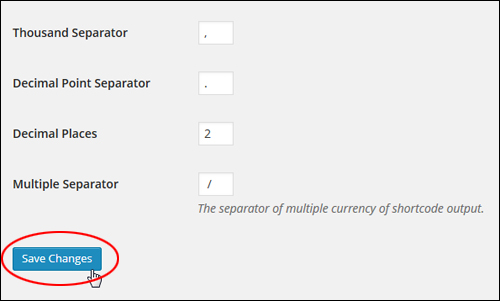
When your plugin settings have been configured, you can easily start adding currency conversion to any WP page using a shortcode.
Refer to the ‘Additional Plugin Notes’ section further below to learn how to use currency codes (e.g. USD, GBP, ZAR, etc …) with the Currencyr plugin.
Using Plugin Shortcodes
You can easily insert currency conversion into WP posts, pages and widgets with no programming knowledge or skills using shortcodes.
Below are some examples of currency shortcodes that you can add to your WP pages and posts:
Let’s say that you retail an item for a fixed amount (e.g. $175) in US Dollars (USD), and you want to show the conversion amount in British pounds (GBP) on your sales page.
All you need to do is insert the shortcode below to your post or page …

Note: You can also insert prices in dollars and cents (for example, 155.25, 189.00, 295.75, etc …)
The example below shows how the above shortcode should look once you have added it to the post or page …
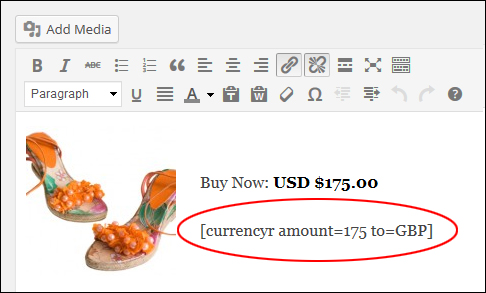
After publishing the page, your currency conversion will then appear as shown below …
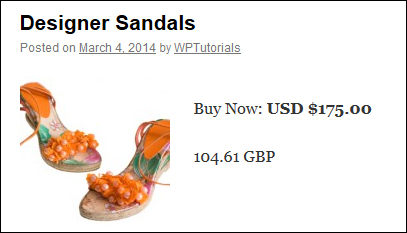
Using this example, let’s now convert the same amount into multiple currency formats.
To do this, use the shortcode shown below (add as many currency symbols as you want by using vertical pipes) …

You can see how the shortcode appears when added to a page …

After publishing your post, your currency conversion will then display like this …
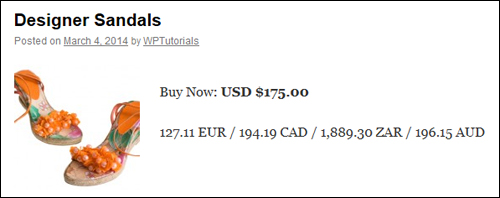
refer to the ‘Additional Plugin Notes’ section at the end of this tutorial to learn how to change the currency separator symbol within this plugin.
Now, let’s say that you want to select a different base currency than the one you have set as the default.
For example, if you have specified your default base currency as EUR and you have a section on your website targeted to non-European visitors (for example, Australia or Canada), you can change the base currency using the following shortcode …

The example below now shows how the above shortcode appears when added to your content …
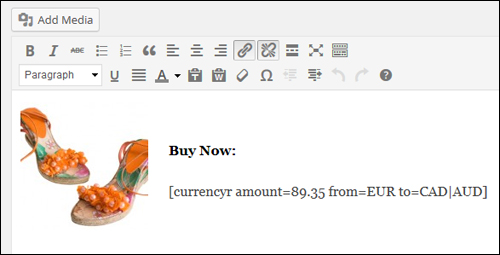
Once the content has been published, your currency conversion will then display like this …
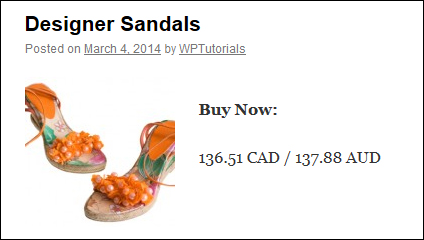
Widget
You can also insert currency conversion into your site’s sidebar menu using the plugin’s widget.
To add the currency converter to your sidebar area, choose Appearance > Widgets from your WP admin menu …
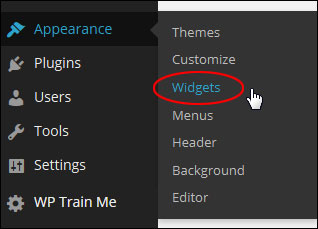
In the Widgets > Available Widgets area find the ‘Currencyr’ widget and add it to the ‘Active Widgets’ area …
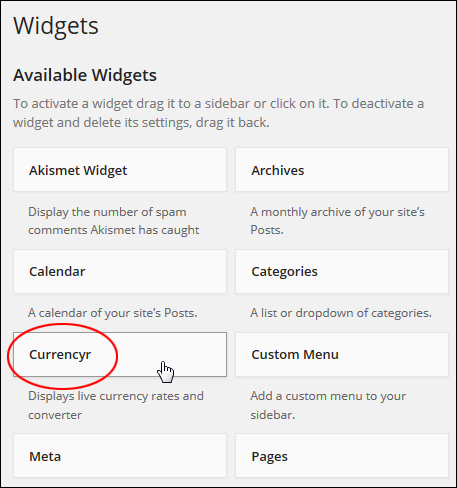
Configure the widget settings as shown below (add currency codes separated by a comma), and click Save to save your settings …

Your currency conversion tool will now display on the sidebar with the options you have specified when configuring the widget …

Additional Plugin Notes
This section contains additional information about using the plugin.
Currency Separator
The Currencyr plugin allows you to specify a symbol of your choice to display as the currency separator when using multiple currencies.
You can change the symbol in the Multiple Separator settings field.
So, for example, using the default symbol “/” (forward slash) …

Displays your currency values separated by a forward slash as you can see in the screenshot below …

If you change the symbol and resave your settings …

Your website visitors will see the new symbol being used as the currency separator …

E-Commerce Platform Integration
As described earlier, the Currencyr plugin can be integrated with a number of WordPress-compatible e-commerce plugins like WooCommerce, Shopp, and Easy Digital Downloads …

(image source: Currencyr plugin site)
And there you have it! Now you know how to easily add a currency converter to your e-commerce web site.
To learn more about WordPress e-commerce plugins, see the tutorial below:
***
"This is an awesome training series. I have a pretty good understanding of WordPress already, but this is helping me to move somewhere from intermediate to advanced user!" - Kim Lednum